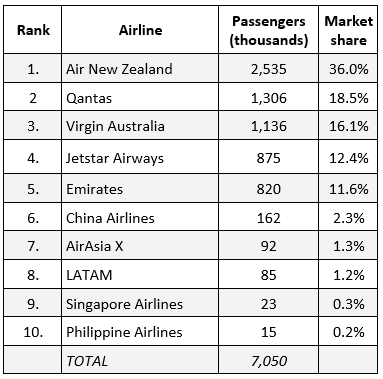Highlights
- Air NZ and Virgin Australia accounted for 52% of Australia-New Zealand passenger traffic in FY2017;
- Air NZ and Virgin Australia will both individually capture a higher share of the Australia-New Zealand market after their divorce as both add capacity;
- Qantas along with its LCC subsidiary Jetstar and partner Emirates captured a 43% share of Australia-New Zealand passenger traffic in FY2017;
- Qantas itself has been gained cross-Tasman market share over the last year as it has expanded to fill the gap left from three Emirates routes suspensions but will lose market share after Air NZ and Virgin Australia expand.
Air NZ carried 36% of total Australia-New Zealand passenger traffic in the fiscal year ending Jun-2017 (FY2017), while partner Virgin Australia carried 16%, according to BITRE data. Both airlines are planning cross-Tasman capacity increases of approximately 15% in late 2018, which could result in Air NZ's market share increasing to over 40% and Virgin Australia's market share approaching 20% in FY2019.
Any market share gains will come at expense of the Qantas Group, the only other major competitor in the Australia-New Zealand market. The Air New Zealand and Virgin Australia divorce essentially results in three competitors, compared to the current Air New Zealand-Virgin Australia versus Emirates-Jetstar-Qantas dupoly.
In FY2017, Emirates, Jetstar and Qantas accounted for a 42.5% share of Australia-New Zealand traffic compared to a 52.1% for Air NZ and Virgin Australia. Five fifth freedom competitors - AirAsia X, China Airlines, LATAM, Philippine Airlines and Singapore Airlines - accounted for the remaining 5% of Australia-New Zealand traffic in FY2017. (Philippine Airlines no longer competes in the Australia-New Zealand market: it dropped Cairns-Auckland in Dec-2017 as it launched nonstop service on the Manila-Auckland route.)
Australia-New Zealand passenger traffic by airline: FY2017
 Notes: passenger numbers and market share based on local Australia-New Zealand traffic only (traffic continuing beyond Australia or New Zealand on same flight excluded).
Notes: passenger numbers and market share based on local Australia-New Zealand traffic only (traffic continuing beyond Australia or New Zealand on same flight excluded).
Source: CAPA - Centre for Aviation & BITRE.
Emirates market share has dropped significantly in FY2018, due to the suspension of three of its four cross-Tasman routes. Emirates currently only accounts for about 4% of seat capacity in the Australia-New Zealand market compared to 14% a year ago. Its actual market share is lower as some of Emirates' cross-Tasman passengers continue onto Dubai; in FY2017 Emirates flew 11.6% of local Australia-New Zealand passengers.
Qantas has been able to fill most of the void left by Emirates by adding capacity. Qantas' capacity to Australia is up approximately 25% year-over-year, according to CAPA and OAG data. While Qantas has not added as much capacity as Emirates removed, it has generally added enough to sustain market share after factoring in the Emirates traffic which continued onto Dubai.
However, Qantas' market share will inevitably decrease as Air NZ and Virgin Australia expand. Qantas, Jetstar and Emirates combined will likely account for less than 40% of Australia-New Zealand traffic in 2019. A decrease to 35% is even possible if Qantas and Jetstar do not respond to the Air NZ and Virgin Australia increases with their own capacity increases.
Air NZ could surpass the Qantas-Jetstar-Emirates grouping. Air NZ is already by far the largest single airline in the Australia-New Zealand market and is confident that it is able to compete without a partner.
However, an increase in the number of competitors and higher overall capacity levels as a result of the Air NZ-Virgin Australia divorce will pressure fares and load factors. Qantas may be better off ceding market share and letting the two former partners battle it out.